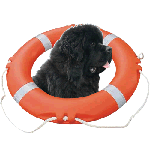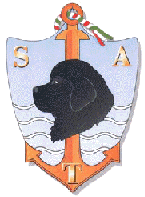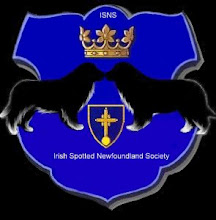Sunday, October 31, 2021
Friday, October 22, 2021
The Ghostly Sighting Of An Ever-Faithful Newfoundland Dog
The ghost of a black Newfoundland dog has been seen many times at the
St. Patrick's Cathedral in Dublin, Ireland, sitting at the base of a memorial statue to Captain John McNeill
Boyd who was lost in February, 1861 while attempting to rescue drowning
seamen at Dun Laoghaire. The apparition is said to be that of Captain
Boyd's devoted dog which has also been seen many times lying on his
master's grave at nearby Glasnevin Cemetery.
On the night of Saturday 8th February, 1861, the Irish Sea was swept by
one of the worst gales of the century. The harbour at Kingstown, now Dun
Laoghaire, was littered with debris and the wreckage of battered
vessels. Scores of bodies of drowned people were found on the
shoreline. Among those who helped to recover the bodies and clear the
wreckage was Captain Boyd, in command of the coastguard vessel Ajax.
Three stricken vessels, the Neptune, the Industry and the Mary, were
trying to get to the shelter of the harbour. The Neptune and the
Industry were to be smashed against the rocks whilst the Mary was
wrecked further along the coast at Sandymount. Captain Boyd and some of
his men were on the rocks trying to rescue the men from the stricken
vessels. Together with three of his men he was swept into the sea by a
giant wave. When a lifeboat from the Ajax later went to search for
Captain Boyd and the three other men, his faithful Newfoundland dog was
in the rescue boat.
When the body of Captain Boyd was finally recovered it was brought
ashore and he was given one of the biggest funerals ever seen in Dublin.
During the funeral procession his faithful dog walked beside the coffin
and followed it to Glasnevin Cemetery where Captain Boyd was interred.
When the grave was filled in, the dog, so devoted to his master, lay on
top and refused to be moved, eventually dying of hunger. Shortly
afterwards the memorial statue to Captain Boyd was erected in the
Cathedral by the people of Dublin.
Wednesday, October 20, 2021
Monday, October 11, 2021
The Dog From Newfoundland
(lewisclark.org)
"The breed of these handsome and powerful dogs, now (in 1840) common in Great Britain, wrote Col. Smith, especially the hound, 'and therefore differs somewhat from the original indigenous race of [North] America.' Newfoundlands of the 1840s in England were larger than those of the original stock in the American colonies, and were generally white with black spots. The original Newfoundland was smaller, the body more slender, forehead more arched, the muzzle sharper, and 'nearly all of a totally black colour, excepting a bright rust coloured spot above each eye, some fulvous [reddish-yellow, tawny] towards the nose, throat, and upon the joints; there was also a little white about the feet, and in the end of the tail.
But those superficial details aside, the breed bore some unique attributes that clearly fitted it for a large, mostly water-borne expedition that expected to meet new strangers frequently. The 'true breed of this race, Smith continued, 'is almost semi-palmated; and, consequently, they swim, dive, and endure the water, better and longer than any other dog in existence.' Joining the chorus of praise and admiration for the breed, he emphasized, 'no dog is better qualified to serve in harness, or fitter to watch and guard property on shore, or vessels in the coasting trade, rivers, or canals. As a waterdog, he can be taught to execute almost any command; and his kind disposition makes training easy, when used in the field.
Smith also invoked the history of these dogs not as pets but seasonal helpmates to generations of fishermen in Nova Scotia and Newfoundland from sometime in the 1400s until the end of the 20th century. Before the 1840s, he wrote, there may have been as many as 2,000 of them around the seaport of St. John's, Newfoundland. Throughout the entire annual cod-fishing season, for nearly 300 years, they were left to shift for themselves while their masters were out on the Grand Banks. Traditionally regarded as descendants of wild dogs and wolves, they were allowed to remain starving, diseased, and even dangerous to the human population. When the fishermen returned, the surviving dogs took up their work again, pulling carts or sleds loaded with firewood, fish for the table, and other bulk supplies until the next cod season began.
Aware of the steadily growing fear of epizoötics of rabies in heavily populated areas in America as well as Europe, Col. Smith added the note that that dreaded disease did not afflict the untended Newfies, but only that a kind of plague, originating in the neglect and misery they suffered, occasionally destroyed great numbers of them.
EARLY 1800's BREED:
The Newfoundland dog, wrote the British naturalist William Taplin (1740?-1807) in 1803, was 'not known amongst us, till imported from that country whose name it continues to bear.' The Newfoundland 'in a state of purity, uncontaminated by the blood of any inferior race," he declared, "is one of the most majestic and awefully [impressively] attracting of all the canine variety.'
Taplin continued with a paean to the breed:
'Docile beyond conception, and affectionate beyond description, the Newfoundland dog is easily taught almost every thing within the power of the human mind to inculcate, of which his own strength and frame are capable. Equally sagacious as energetic, he patiently perseveres in whatever he undertakes, and never relinquishes the attempt so long as there remains the most distant hope, or possibility of success . . . . The sagacity of this animal is so palpably blended with a peculiarly attentive attachment to the human species, and such an instantaneous sense of impending danger, that the inactive mind, lulled to an apathy, becomes immediately roused to action in the contemplation.'
Philip Reinagle (1749-1815), the artist who created this portrait, was known primarily for his landscapes and depictions of familiar animals, especially sporting scenes containing dogs and birds. He created all the drawings for the engravings in Taplin's descriptive catalog of sporting dogs. He places an oversized dog against a background of exaggerated mountain crags, with the added dramatic detail of a working dog team that is just large enough to convey a message, even though it foreshortens the perspective.
WORKING DOG:
The Newfoundland dog, wrote Taplin, 'is habitually used in its native country, for the purposes of draught. They are easily broken in, and soon inured to the trammels of harness; three, four, or five are used in a sledge or other vehicle, and will convey a load of some hundreds weight for many miles with great ease.'
LAND OF THE NEWFIE:
Geographically, the most easterly part of North America is the island called Newfoundland. Named Terre-Neuve— literally 'land-new,' or 'New-(found)-land'—by 15th century explorers. Northwest of Newfoundland, across the Strait of Belle Isle, is Labrador, the larger mainland, peninsular part of the old entities which, in 2001 were politically merged into the province of Newfoundland-Labrador.
West of Newfoundland-Labrador is the Gulf of St. Lawrence; to the southwest beyond Cabot Strait are Cape Breton Island and peninsular Nova Scotia ('New Scotland'). East and south of Newfoundland-Labrador are the plankton-rich waters of the historic, world famous fishing ground known as the Grand Banks—where the Newfoundland dog honed its water skills in behalf of fishermen from the nearby provinces and New England. Since 1990, a wide variety of technological "advances" have led to over-fishing and a corresponding decline of commercially viable fish populations.
A key observation here: "there was also a little white about the feet, and in the end of the tail."
Friday, October 1, 2021
Subscribe to:
Posts (Atom)


















































